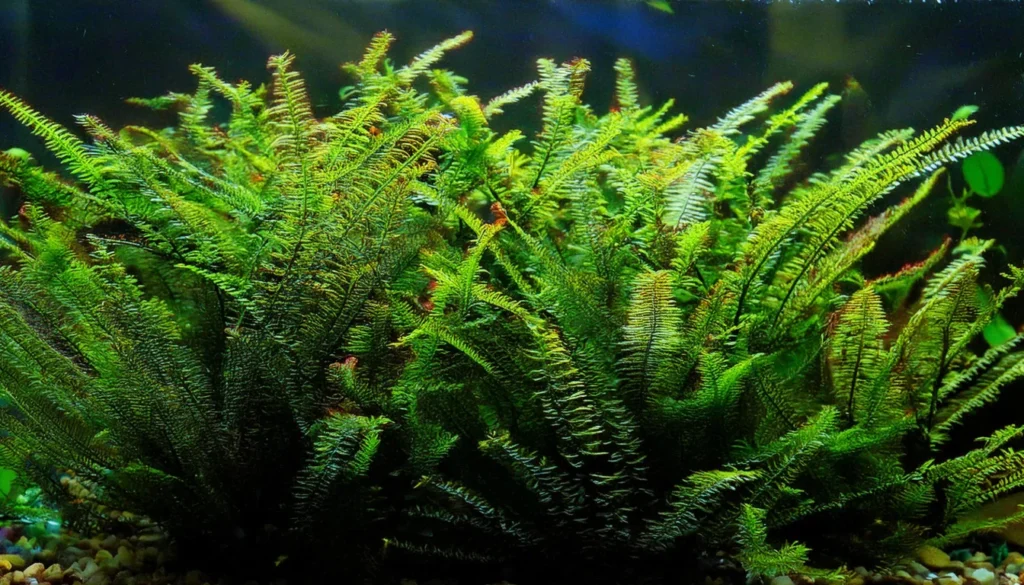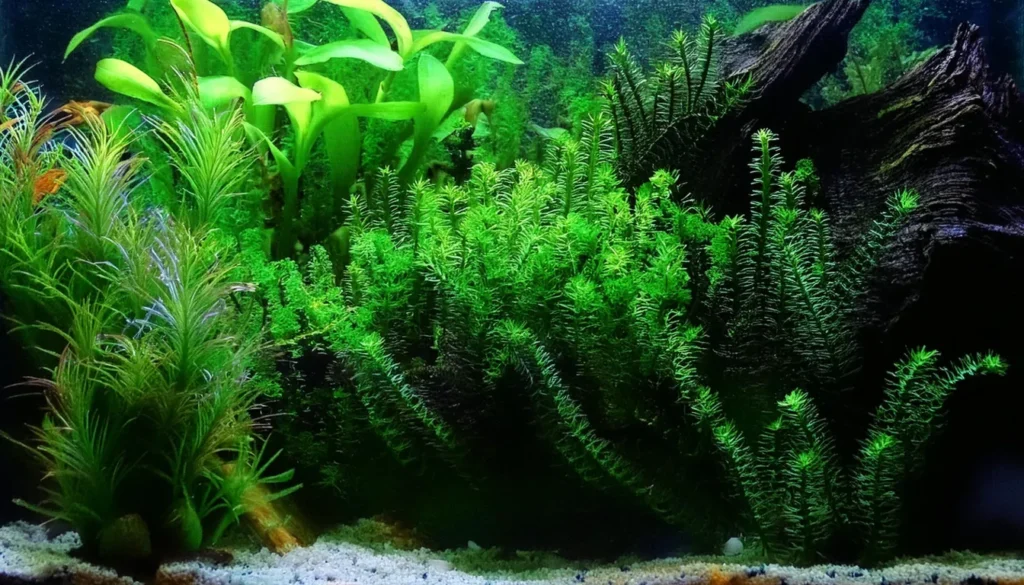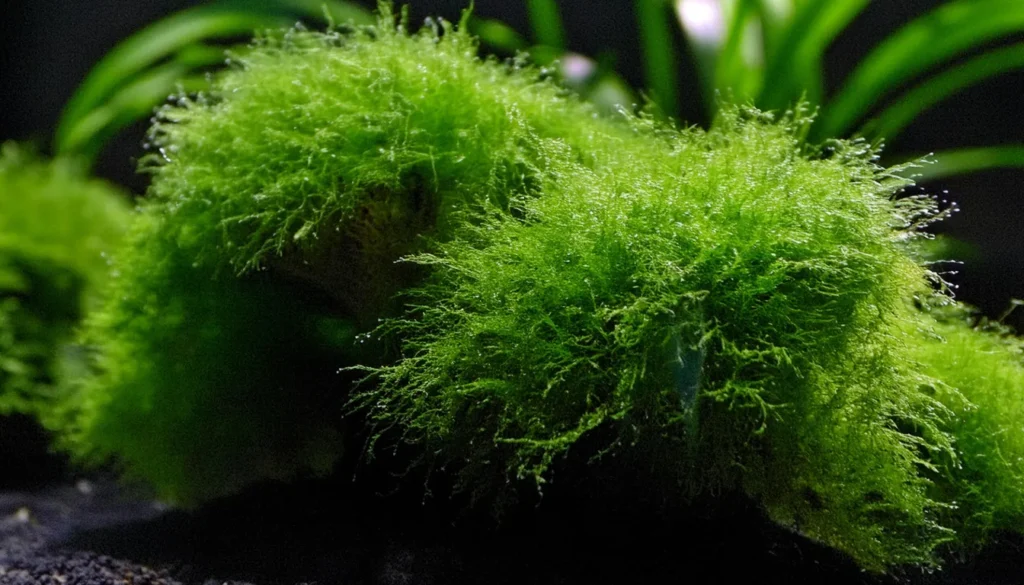Welcome to our comprehensive guide on caring for Vesicularia Montagnei, also known as Christmas moss or Xmas moss. As a popular choice for aquariums and aquascapes, this aquatic moss adds beauty and depth to any planted tank.
Whether you are a beginner or an experienced aquarist, we have gathered all the care tips you need to successfully grow and maintain Vesicularia Montagnei in your freshwater aquarium.
From its natural habitat and physical characteristics to lighting demands, temperature needs, and nutrient requirements, we’ll cover everything you need to know to create a thriving environment for this stunning tropical plant.
Key Takeaway
- Vesicularia Montagnei, also known as Christmas moss or Xmas moss, is a popular aquatic moss for aquariums and aquascapes.
- It thrives best with moderate to high lighting levels and a temperature range of 68-82°F (20-28°C).
- Christmas moss can tolerate a wide range of water conditions, from slightly acidic to slightly alkaline, and both soft and hard water.
- Regular trimming, controlling algae growth, and maintaining stable water conditions are essential for its maintenance.
- Planting Vesicularia Montagnei in your aquascape enhances the aesthetic appeal, improves water quality, and provides hiding places for tank mates.

Quick Stats
| Attribute | Details |
| Scientific Name | Vesicularia montagnei |
| Common Name | Christmas Moss |
| Origin | Cosmopolitan distribution, native to Southeast Asia |
| Height | 3-5 cm (1.2-2 inches) |
| pH Range | 5.0 – 7.5 |
| CO2 Requirement | Low to Medium |
| Growth Rate | Moderate |
| Care Level | Easy to Moderate |
| Color Form | Bright green |
| Water Conditions | 18-26°C (64-79°F), adaptable to various water parameters |
| Max Size | Typically remains within the stated height range |
| Lighting | Low to Moderate |
| Supplements | Minimal; benefits from occasional liquid fertilization |
| Placement | Foreground to Midground |
| Propagation | Through division or by attaching small portions to surfaces |
What Is Vesicularia Montagnei?
Vesicularia Montagnei, also known as Christmas moss or Xmas moss, is a species of aquatic moss that belongs to the division Bryophyta.
It is popular for aquarium enthusiasts due to its attractive appearance and ease of care.
Christmas moss is named from its frond growth pattern, which resembles a Christmas tree.
The fronds start out wide and taper at the tip, giving it a unique and decorative look.
With its broad, short cells and thin walls, Vesicularia Montagnei thrives in warmer water than other moss species.
It is often used to create moss walls and cover objects in aquariums.
While Christmas moss may be confused with Java moss (Taxiphyllum barbieri), they have distinct characteristics that set them apart.
RELATED: Vallisneria Nana Care & Growth Guide Essentials For Beginners
Natural Habitat And Origin
- In its natural habitat, Vesicularia Montagnei can be found growing above the surface of the water. This popular aquatic moss thrives on rocks along riverbanks and streams, where it receives the necessary water supply from the spray and moist air.
- In some habitats, Vesicularia Montagnei forms dense mats that cover the forest floor, adding to the environment’s overall biodiversity. This adaptable moss can be found in warm, tropical countries such as India, Indonesia, and the Philippines, as well as in other regions, including Australia, China, Japan, and the Arab Peninsula. Vesicularia Montagnei has evolved to tolerate a wide range of water conditions, reflecting its resilience and versatility as an aquarium plant.

Physical Characteristics
- Vesicularia Montagnei, also known as Christmas moss, possesses unique physical characteristics that distinguish it from other moss species, including the commonly used Java moss (Taxiphyllum barbieri). Christmas moss displays a distinctive growth pattern with fronds that have a wider base and taper to a point, resembling the shape of a Christmas tree. In contrast, Java moss has straighter and spindlier fronds.
- Their cell structure further emphasizes this divergence in frond shape. Christmas moss features broad, short cells with thin walls, while Java moss exhibits long, narrow cells that are thicker. The contrasting frond shape and cell structure of these two moss species contribute to their distinct visual appearances.
| Characteristics | Vesicularia Montagnei | Java Moss (Taxiphyllum barbieri) |
| Frond Shape | Wider base, tapering to a point | Straighter and spindlier |
| Cell Structure | Broad, short cells with thin walls | Long, narrow cells that are thicker |
| Water Temperature | Requires warmer water | Tolerates cooler water |
| Light Requirement | Requires more light | Tolerates lower light levels |
Lighting Demands For Optimal Growth
- Proper lighting is crucial for the optimal growth and development of Vesicularia Montagnei in your aquarium. This beautiful moss species requires moderate to high lighting levels to thrive and achieve its vibrant green coloration.
- To meet Vesicularia Montagnei’s lighting demands, it is recommended that approximately 2-3 watts per gallon of light intensity be provided. This will ensure that the moss receives enough light energy for photosynthesis, which is essential for its metabolic processes and overall health.
- The duration of light exposure should be around 8-10 hours per day. Consistency in light duration is important to maintain a stable light cycle and provide the moss with the appropriate amount of light for growth and development.
- Monitoring the lighting conditions is crucial to avoid overexposure or insufficient light for the moss. If you notice signs of excessive or inadequate lighting, such as browning or bleaching of the moss, it may be necessary to adjust the lighting intensity or duration accordingly.
Temperature Needs Of The Plant
Vesicularia Montagnei is adaptable to a wide range of temperatures typically found in tropical aquariums.
However, it thrives best within a temperature range of 68-82°F (20-28°C).
This temperature range provides optimal conditions for the growth and overall health of the moss.
It is important to keep the aquarium water temperature stable within this range to ensure the well-being of Vesicularia Montagnei.
RELATED: Exploring The Underwater Grace Of Vallisneria Americana
| Temperature Range | Aquarium Condition |
| Below 68°F (20°C) | Vesicularia Montagnei may grow at a slower rate and exhibit signs of stress. |
| 68-82°F (20-28°C) | Optimal temperature range for Vesicularia Montagnei’s growth and overall health. |
| Above 82°F (28°C) | Vesicularia Montagnei may experience accelerated growth, but it can also become more susceptible to certain diseases and algae overgrowth. |

Optimal Water Condition
- Aquarium Water pH Levels: Vesicularia Montagnei generally prefers slightly acidic to neutral water with a pH range of 6.0-7.5. However, it can also thrive in a slightly alkaline environment with a pH up to 8.0. Maintaining stable pH levels within this range is important for the moss’s growth and overall health.
- Water Hardness: Vesicularia Montagnei is adaptable to both soft and hard water. It can tolerate a range of water hardness levels, providing flexibility in choosing the appropriate water source for your aquarium.
- Water Flow: This moss thrives in various water flow conditions, from low to moderate. It can adapt to different water currents without compromising its growth and well-being.
Substrate Requirement
- Vesicularia Montagnei, also known as Christmas moss or Xmas moss, can be attached to various surfaces in the aquarium, such as rocks, driftwood, or other decorations. Unlike some plants, it does not require a specific type of substrate for attachment or growth. However, using a nutrient-rich substrate or planting medium can provide additional benefits and contribute to the overall health and growth of the moss.
- A fine-grained substrate or planting medium can help with moss attachment and promote root development, although Christmas moss does not have true roots. By providing a suitable substrate, you create a stable foundation for the moss to grow and thrive in your aquarium.
Placement Option In The Tank
- Foreground: Placing Vesicularia Montagnei in the foreground of the tank can create a focal point and add depth to the overall aquascape. The lush greenery of the moss will be prominently featured, drawing the viewer’s attention and creating a captivating visual display.
- Midground: Another placement option is the midground, where Vesicularia Montagnei can act as an accent plant amongst other aquatic plants or decorative elements. This positioning adds interest and dimension to the aquascape, creating a sense of balance and harmony.
- Background: For a lush green backdrop, consider placing Christmas moss in the aquarium’s background. This placement option provides beautiful and vibrant greenery that complements other plants or decorations placed in the foreground or midground.
Recommended Tank Size
- Vesicularia Montagnei, also known as Christmas moss or Xmas moss, can be grown in a variety of tank sizes, making it suitable for different aquascapes and tank inhabitants. Whether you have a small nano tank or a large aquarium, Vesicularia Montagnei can add natural beauty to your setup.
- If you have a small tank with a 5-10 gallons capacity, you can still create a visually appealing aquascape with Vesicularia Montagnei. This moss can add lush greenery to your smaller tank, creating a vibrant and natural environment for your aquatic inhabitants.
- On the other hand, if you have a larger tank, Vesicularia Montagnei can be a fantastic addition to a more complex aquascape design. Combining this moss with other plants and decorations creates a stunning underwater landscape that mimics nature.
- When planning the tank size for Vesicularia Montagnei, consider the space needed for the moss to grow freely and have enough water circulation. To create a balanced and harmonious environment, it’s also important to ensure compatibility with other tank inhabitants, such as fish and invertebrates.

Suitable Tank Mates
Vesicularia Montagnei, also known as Christmas moss or Xmas moss, is a versatile aquarium plant that can coexist harmoniously with various tank mates.
Whether you have a community tank or a dedicated planted tank, Vesicularia Montagnei can greatly enhance the overall aesthetics and biological diversity.
When considering suitable tank mates for Vesicularia Montagnei, factors such as water parameters, temperament, and feeding habits must be taken into account.
Choosing compatible fish and shrimp species ensures a peaceful and thriving aquarium ecosystem.
Some suitable tank mates for Christmas moss include:
- Neon Tetras
- Guppies
- Rasboras
- Cherry Shrimp
- Amano Shrimp

Neon Tetras, known for their vibrant colors, are peaceful schooling fish that can create a beautiful contrast with the greenery of Vesicularia Montagnei.
With their striking patterns, guppies add a lively touch to the aquarium. Rasboras are small and peaceful fish that can coexist with the moss and add an active and dynamic presence.
| Tank Mates | Description |
| Neon Tetras | Peaceful schooling fish with vibrant colors. |
| Guppies | Colorful fish with striking patterns. |
| Rasboras | Small and peaceful fish that add activity to the aquarium. |
| Cherry Shrimp | Peaceful shrimp species that serve as natural cleaners. |
| Amano Shrimp | Shrimp species that contribute to aquarium cleanliness. |
Nutritional Needs Of The Plant
- Vesicularia Montagnei, or Christmas moss, has relatively low nutritional requirements compared to some other aquarium plants. This versatile aquatic moss can derive nutrients from the water column, absorbing essential micronutrients and macronutrients. However, to support its growth and overall health, Christmas moss can benefit from additional supplementation. One way to provide these nutrients is through the use of liquid aquarium fertilizers.
- These fertilizers contain the necessary micronutrients and macronutrients, such as iron, potassium, and nitrogen, to promote healthy growth. When using aquarium fertilizers, it is important to carefully follow the instructions and dosage recommendations, as excessive fertilization can result in undesirable effects, such as algal growth.
- Maintaining a balanced approach to nutrient supplementation will help ensure the thriving and well-being of Vesicularia Montagnei in your aquarium.
Essential Maintenance Tips
- Regular Trimming: Trim overgrown fronds to maintain the desired shape and prevent the moss from becoming too dense. This promotes healthy growth and improves water circulation.
- Algae Control: Monitor nutrient levels, adjust lighting, and implement proper algae control measures to prevent excessive algae growth. This includes maintaining a balanced ecosystem and ensuring optimal water conditions for Christmas moss.
- Water Changes: Regular water changes help maintain water quality and replenish essential nutrients for the moss. Aim for weekly or bi-weekly water changes to keep the aquarium environment clean and healthy.
- Substrate Cleaning: Clean the substrate regularly to remove debris, dead plant matter, and excess nutrients that can contribute to algae growth. This prevents water quality issues and promotes a clean and thriving environment for Vesicularia Montagnei.
- Equipment Maintenance: Regularly clean and maintain your aquarium equipment, such as filters and heaters, to ensure they function properly. This helps maintain stable water conditions and supports the overall health of Vesicularia Montagnei.

Cultivating Vesicularia Montagnei At Home
- Lighting: Vesicularia Montagnei requires moderate to high lighting levels to thrive. Provide adequate lighting to support its photosynthesis and promote healthy growth.
- Temperature: Keep the aquarium temperature within the range of 68-82°F (20-28°C) to ensure optimal conditions for the moss.
- Water Condition: The moss can tolerate a wide range of water parameters. It is adaptable to various pH levels and water hardness. Maintain stable water conditions and monitor parameters regularly.
- Substrate: Vesicularia Montagnei can be attached to rocks, driftwood, or other decorations in the aquarium. While it doesn’t require a specific substrate, using a nutrient-rich planting medium can enhance its growth.
Plant Propagation Tips
- Division: One method of propagation is through division. You can separate clumps of Vesicularia Montagnei into smaller portions by gently pulling apart the moss. This can be done when the moss has become overgrown or when you want to create new patches of Christmas moss in different areas of your tank. Once divided, these smaller portions can be attached to other surfaces, such as rocks or driftwood, using thread or glue. Alternatively, you can leave them free-floating in the water, allowing them to develop new growth and establish themselves.
- Fragmentation: Another effective propagation method is fragmentation. This involves breaking the moss into smaller fragments, usually by hand. The fragments can then be attached to surfaces or left free-floating to develop new growth. Fragmentation can be particularly useful when you want to create a moss wall or cover a larger area in your aquarium with Vesicularia Montagnei.
Benefits Of Planting Vesicularia Montagnei
- Planting Vesicularia Montagnei in your aquarium or aquascape offers several benefits. First and foremost, it enhances the aesthetic appeal of the tank by adding lush greenery and creating a natural and visually pleasing environment. The vibrant and intricate frond pattern of Vesicularia Montagnei brings an element of beauty and elegance to any aquatic setting, transforming a plain tank into a captivating underwater landscape.
- In addition to its aesthetic charm, Vesicularia Montagnei provides practical advantages for the tank inhabitants and the overall water quality. The dense and intricate growth pattern of this moss offers hiding places and shelter for small fish and invertebrates, creating a refuge where they can seek protection and feel secure. This contributes to a harmonious and natural ecosystem in the aquarium, promoting the well-being and natural behavior of the aquatic inhabitants.

Conclusion
Vesicularia Montagnei, also known as Christmas moss or Xmas moss, is a versatile and visually appealing aquatic moss that can enhance the beauty of your aquarium or aquascape.
By following the care tips provided in this guide, you can create an ideal environment for Vesicularia Montagnei to thrive and grow.
From providing the right lighting and temperature conditions to maintaining optimal water quality and regular maintenance, every aspect of caring for this moss has been covered.
By incorporating Vesicularia Montagnei into your aquascape, you can enjoy the benefits of its lush greenery and contribute to a healthy and visually appealing aquarium.
This moss not only adds aesthetic appeal but also provides hiding places and shelter for small fish and invertebrates, creating a harmonious and natural ecosystem.
Additionally, Vesicularia Montagnei helps improve water quality by absorbing nitrates, competing with algae for nutrients, and providing a surface area for beneficial bacteria.
RELATED: Unraveling The Underwater Elegance Of Vallisneria Neotropical
Frequently Asked Questions
What Are Suitable Tank Mates For Vesicularia Montagnei?
Vesicularia Montagnei is compatible with a wide range of peaceful fish and shrimp species. Some suitable tank mates include neon tetras, guppies, rasboras, cherry shrimp, and amano shrimp.
What Are The Nutritional Needs Of Vesicularia Montagnei?
Vesicularia Montagnei has relatively low nutritional requirements.
It can derive nutrients from the water column and can benefit from regular water changes that replenish essential micronutrients and macronutrients.
What Maintenance Tips Should Be Followed For Vesicularia Montagnei?
Regular trimming of overgrown fronds, controlling algae growth, and maintaining stable water conditions are essential for the successful maintenance of Vesicularia Montagnei in the aquarium.
Regular water changes, substrate cleaning, and equipment maintenance are also important.
How Can Vesicularia Montagnei Be Propagated?
Vesicularia Montagnei can be propagated through division, fragmentation, and attaching new growth to surfaces. Clumps can be divided into smaller portions, fragments can be created by breaking the moss, and new growth can be attached to new surfaces or left free-floating to develop.
What Are The Benefits Of Planting Vesicularia Montagnei In The Aquarium?
Planting Vesicularia Montagnei enhances the aesthetic appeal of the aquarium, provides hiding places and shelter for small fish and invertebrates, helps improve water quality by absorbing nitrates and competing with algae, and promotes a healthy and vibrant aquatic environment.
- Unveiling The Wonders Of Riccia Fluitans In Aquascapes - August 7, 2024
- Vallisneria Gigantea Var. Guide To Care And Cultivation At Home - July 31, 2024
- Vesicularia Dubyana Care & Growth Guide Tips For Beginner Gardeners - July 30, 2024
